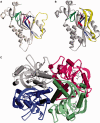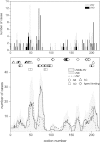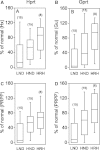Genotype-phenotype correlations in neurogenetics: Lesch-Nyhan disease as a model disorder
- PMID: 23975452
- PMCID: PMC3999711
- DOI: 10.1093/brain/awt202
Genotype-phenotype correlations in neurogenetics: Lesch-Nyhan disease as a model disorder
Abstract
Establishing meaningful relationships between genetic variations and clinical disease is a fundamental goal for all human genetic disorders. However, these genotype-phenotype correlations remain incompletely characterized and sometimes conflicting for many diseases. Lesch-Nyhan disease is an X-linked recessive disorder that is caused by a wide variety of mutations in the HPRT1 gene. The gene encodes hypoxanthine-guanine phosphoribosyl transferase, an enzyme involved in purine metabolism. The fine structure of enzyme has been established by crystallography studies, and its function can be measured with very precise biochemical assays. This rich knowledge of genetic alterations in the gene and their functional effect on its protein product provides a powerful model for exploring factors that influence genotype-phenotype correlations. The present study summarizes 615 known genetic mutations, their influence on the gene product, and their relationship to the clinical phenotype. In general, the results are compatible with the concept that the overall severity of the disease depends on how mutations ultimately influence enzyme activity. However, careful evaluation of exceptions to this concept point to several additional genetic and non-genetic factors that influence genotype-phenotype correlations. These factors are not unique to Lesch-Nyhan disease, and are relevant to most other genetic diseases. The disease therefore serves as a valuable model for understanding the challenges associated with establishing genotype-phenotype correlations for other disorders.
Keywords: Lesch-Nyhan disease; genotype–phenotype correlations; neurogenetics.
Figures






References
-
- Anderson LT, Ernst M. Self-injury in Lesch-Nyhan disease. J Autism Dev Disord. 1994;24:67–81. - PubMed
-
- Anderson LT, Ernst M, Davis SV. Cognitive abilities of patients with Lesch-Nyhan disease. J Autism Dev Disord. 1992;22:189–203. - PubMed
-
- Aral B, de Saint B, Al-Garawi S, Kamoun P, Ceballos-Picot I. Novel nonsense mutation in the hypoxanthine guanine phosphoribosyltransferase gene and nonrandom X-inactivation causing Lesch-Nyhan syndrome in a female patient. Hum Mutat. 1996;7:52–8. - PubMed
-
- Augoustides-Savvopoulou P, Papachristou F, Fairbanks LD, Dimitrakopoulos K, Marinaki AM, Simmonds HA. Partial hypoxanthine-guanine phosphoribosyltransferase deficiency as the unsuspected cause of renal disease spanning three generations: a cautionary tale. Pediatr. 2002;109:E17. - PubMed
Publication types
MeSH terms
Substances
Grants and funding
LinkOut - more resources
Full Text Sources
Other Literature Sources
Miscellaneous

